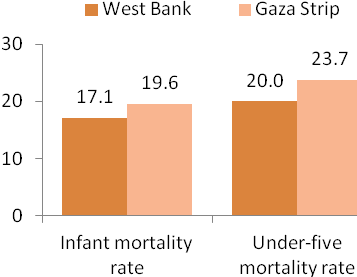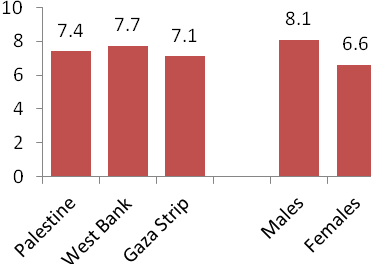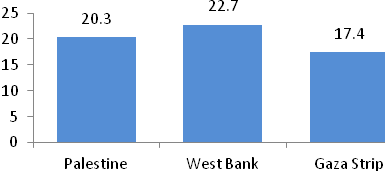The Palestinian Central Bureau of Statistics (PCBS) and the Ministry of Health (MOH) Issue a Press Release on the Occasion of International Health Day 07/04/2015
World Health Day 2015
The World Health Day, an opportunity for the revitalization of the work to protect people's health and well-being, highlights this year is the theme of "food safety". Food safety is one of public health priorities because millions of people become ill and many of them die of unsafe food. Food with harmful bacteria, viruses, parasites, or chemicals is responsible for over 200 diseases ranging from diarrhea to cancer.
The purpose of this campaign is to alert the public about the importance of food safety, and make them aware of the role they can play to foster our confidence in the food we eat.
Iodized Salt
73.2% of households in Palestine used salt, with at least 15 ppm of iodine in 2014; 69.3% in the West Bank and 79.7% in Gaza Strip.
Improved drinking water sources
61.5% of household members in Palestine use safe drinking water source in 2014, and this percentage is higher in the West Bank (96.8%) in comparison to Gaza Strip (10.4%). Palestinian Multiple Indicator Cluster Survey (PMICS) shows also showed variation by type of locality with most access to safe water sources in the rural areas (86.9%) compared with urban areas and camps, which scored 58.1% and 42.3% respectively.
Infant and Under-five Mortality Rate
In 2014, the under-five mortality rate in Palestine was 21.7 per 1000 live births; 20.0 in the West Bank compared with 23.7 in Gaza Strip. On the other hand infant mortality rates in Palestine reached 18.2 per 1000 live births; 17.1 in the West Bank and 19.6 in Gaza Strip.
Infant and Under-five Mortality Rate

Malnutrition in Children Under Five Years
7.4% of children under the age of five in Palestine suffer from moderate and severe stunting in 2014. Male children under five years suffer from moderate and severe stunting more than females: the rate was 8.1% for males and 6.6% for females. The percentage was 7.7% in the West Bank and 7.1% in Gaza Strip.
Malnutrition (Stunting) between Children Under Five Years

In 2014, 96.6% of children aged 0-23 months in Palestine were breastfed: 95.8% in the West Bank and 97.6% in Gaza Strip. The data showed that 40.8% of children in that age group were breastfed within the first hour of birth: this percentage was almost the same in the West Bank (40.7%) and in Gaza Strip (41.0%).
As regards to continuing breastfeeding till the age of one year, the data showed that 52.9% of children aged 12-15 months in Palestine were still breastfed; 48.8% in the West Bank versus 58.7% in Gaza Strip. While the percentage was in the age group 20-23 months 11.5% in Palestine by 13.8% in the West Bank and 8.4% in Gaza Strip.
Vaccinations
Data indicated that 97.0% of children aged 24-35 months had received measles vaccine; 96.9% in the West Bank compared with 97.1% in Gaza Strip. Results also indicated that the percentage of children in the same age group who had received all vaccines is 89.9%, by 89.8% in the West Bank and 90.0% in Gaza Strip.
Reproductive Health
Fertility Rates
The total fertility rate in Palestine was 4.1 births per woman with 3.7 births in the West Bank and 4.5 births in Gaza Strip. The adolescent birth rate (Age-specific fertility rate for women age 15-19) in Palestine were 48 births per 1000 women; this percentage was higher in Gaza Strip and stood at 66 births per 1000 women compared to 35 births per 1000 women in the West Bank.
Use of family planning methods
More than half of married women aged 15-49 years in Palestine used a family planning method (57.2%) in 2014 (59.8%) in the West Bank and (53.4%) in Gaza Strip.
59.9% of currently married women aged 15-49 years in rural areas used contraceptives, which is a higher rate in comparison to women in urban areas and camps, (56.6% in urban areas and 57.6% in camps).
Antenatal Care
95.5% of women aged 15-49 years received health care during pregnancy at least 4 times by any health care provider in 2014; 95.7% in the West Bank compared with 95.3% in Gaza Strip. Data however showed that 85.4% of these visits were in the first three months of pregnancy, with a clear difference between women from the West Bank (93.0%) and Gaza Strip, (76.2%).
Health Care during Delivery and Caesarean Births
Most births in Palestine occur in health institutions, where 99.3% of births took place in health institutions with 99.3% in the West Bank compared with 99.4% in Gaza Strip. Data additionally indicated that 20.3% of births in Palestine were by Caesarean section and this percentage rises in the West Bank, to reach 22.7% compared with 17.4% in Gaza Strip.
Caesarean Births

Post-natal Care
90.7% of women 15-49 years received health care after birth, both during their stay in the health institutions or at home after birth or during a visit to post-natal care within two days of birth; 89.7% in the West Bank and 91.8% in Gaza Strip.
The data also showed that 93.9% of births received health check, either while in the health facility, or at home after birth, or received health care after childbirth within two days after birth; with 96.9% in the West Bank compared with 90.2% in Gaza Strip.
 عربي
عربي